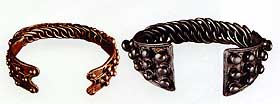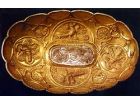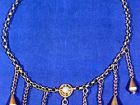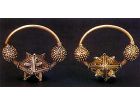THE NIKOPOL TREASURE - ONE OR TWO TREASURES IN BALINOVTZI
THE NIKOPOL TREASURE
ONE OR TWO TREASURES IN BALINOVTZI
ONE OR TWO TREASURES IN BALINOVTZI
The story of this family jewelry is really unusual. For we are talking of two finds discovered one after the other and very close to each other in a period of more than 50 years. For that reason they are known to historians as the First and Second Nikopol Treasures. The proximity, their character and the style of the objects, the period of the coins in the treasures give us ground to presume that this is one and the same treasure. But before giving an answer to this question, we must describe them.
The First Nikopol Treasure was discovered in 1915 in the area of Harmanlak near Nikopol, in a vineyard. While digging the ground people found near the surface a copper bowl containing two silver cups, parts of a larger silver vessel, silver spoons and jewelry (belt applications, earrings and a bracelet). Of great importance are the coins of the Bulgarian kings Ivan Alexander (depicted with his son Michael), Ivan Sratsimir, of the Turkish Sultan Baiazid I and of the Wallach voivode Mircho I the Old. The last two died in the beginning of the 15th c. (1402 and 1418). Therefore the treasure dates from a previous period the ground in 1971 the tractor unearthed at the same spot and at 50 cm deep another treasure, called the Second Nikopol Treasure. Generally it consists of analogical objects — vessels, jewelry, coins of the Bulgarian kings Ivan Alexander, Michael Shishman, Ivan Shishman, Ivan Sratsimir, of the Turkish Sultans Murad I and Baiazid I Ildarum, as well as of the Wallach voivode Vladislav I and Mirchol. Naturally the youngest coins could be attributed to the period of the beginning of the 15th c. Some scholars consider that these two numismatic finds are not two separate treasures but one but later divided into two.
Generally speaking the objects in the two treasures are of the same type and most of them are made of silver of very high quality (mostly the vessels), while the jewelry is made of gold. For example, the Second Treasure alone contains 3.5 kg of silver and about 300 g of gold. Some of the vessels are gilded.

The jewels are of various kinds and functions: gold ear pieces with bi-conical, pyramidal and spherical from, bracelets made of rounded gold wire, spherical and semi-spherical dress buttons (in the Second Treasure they are 157) made of silver and gilded, a gold necklace with pendants, silver neck rings (torkvi). The vessels include small bowls, cups and several dishes and deep plates. Here belong silver spoons with inscriptions in Bulgarian on some of them.
Various techniques of jewelry making are used, based on applying special molds. The vessels have rich ornaments of plant, geometrical, zoomorphic and rarely anthropomorphic motifs. Very rich is the ornamentation of one of the ellipse-like bowls of gilded silver. While with the other vessels the ornaments are found only on the bottoms, the surface of this bowl is fully covered with images of plants, animals and birds enclosed as a rule into round or ellipse-like medallions.
After the molding of the objects (primarily the jewels) they receive additional ornaments by using granulation, filigree, engravings, inlays of glass paste and glass crosses (the cell techniques). These goldsmith's techniques create a rich and plastic decoration, which makes the treasure into a paragon of applied art.
The question of whether we are dealing with two different treasures or one divided into two is much more difficult. The close proximity and the similarities in style are not enough to give a categorical answer. Some scholars suggest that the treasure has been buried into the ground about 1396, when the Turks destroyed the Christian army of Hungarians and Poles lead by the Hungarian king Sigizmund. This happened not far from the town of Nikopol and in those troublesome times some of the members of Nikopol aristocracy left the town hiding their valuable objects hoping to return.
It is believed that the Second Nikopol Treasure was buried in 1444, the time of the march of the Polish king Vladislav Yagelo, who perished by Varna and was called Varnenchik. The Christian army consisting of Poles, Hungarians, Czechs, Serbians, and Bulgarians besieged Nikopol but didn't succeed in capturing it. It is possible that after lifting the siege some of the nobles of Nikopol followed Vladislav's army seek refuge. The might have buried their riches, in a manner similar to the First Treasure. Fortunately the inscriptions on the silver spoons allow us to know the name of the owner of the Second Treasure. Marking the owner of the spoons, the inscriptions contain the name Balin (Balina, which suggests family relations with the Nikopol noble Todor Balina). At the end of the 16th c. he organized a failed rebellion against the Turks. It is highly possibly that the Balina from the treasure was some of his predecessors.
If we accept the versions about the two treasures being buried at different times, divided by almost 50 years, it is difficult to image them being parts of the same treasure. But such a hypothesis cannot be completely discarded. As we can see the valuable items in the treasure were the property of an aristocratic family from Nikopol and we can presume that it has been handed down from generation to generation. On the other hand their similarity allows that such objects were very common among the nobles in general since they represent the popular fashion of the time. In any case the items of goldsmith's craftsmanship - jewels and vessels - are central in studying a crucial period of Bulgarian history, when it fell under foreign domination for centuries. Despite various foreign influences, a Western one included, they are the product of the Bulgarian craftsmen.







